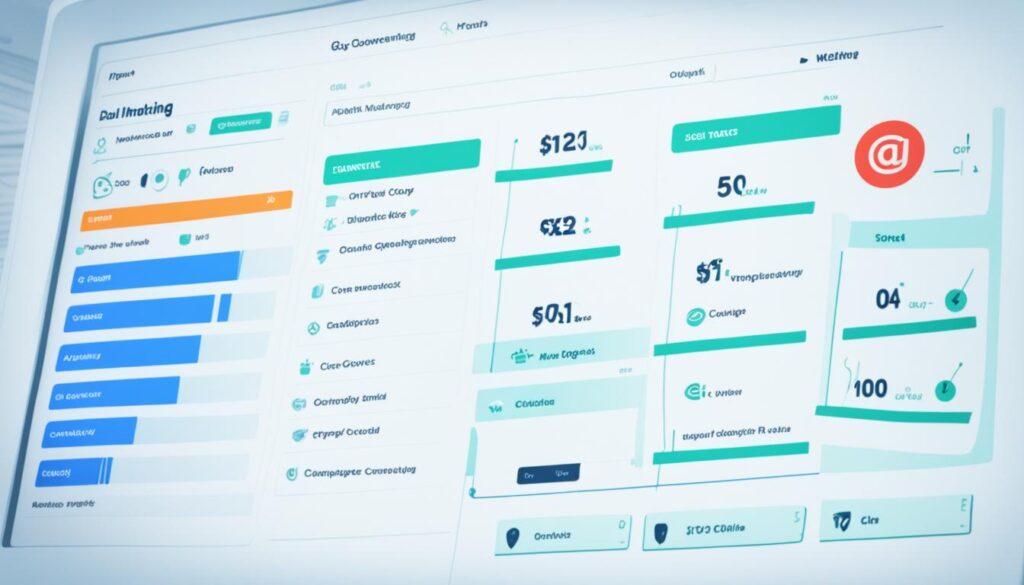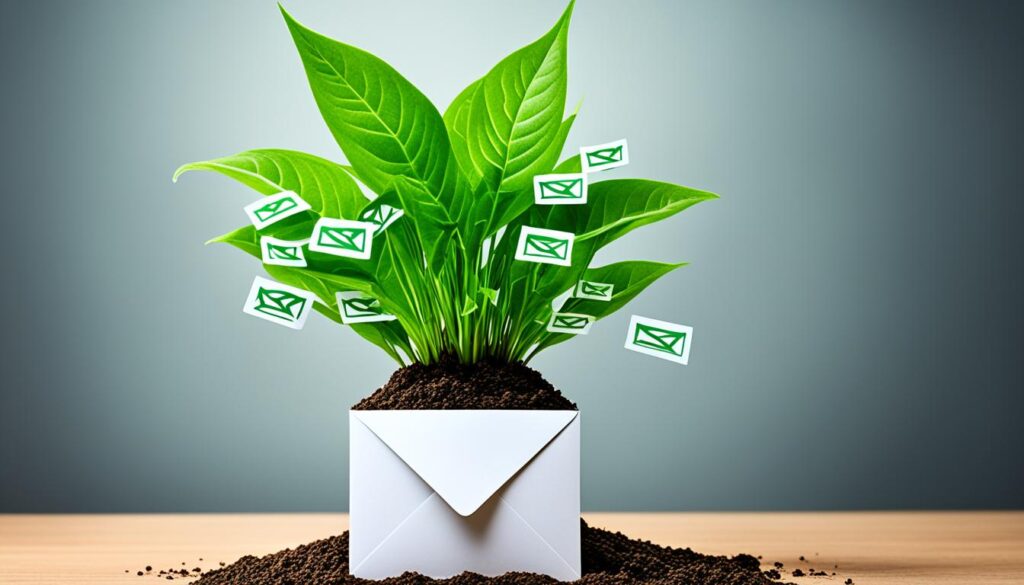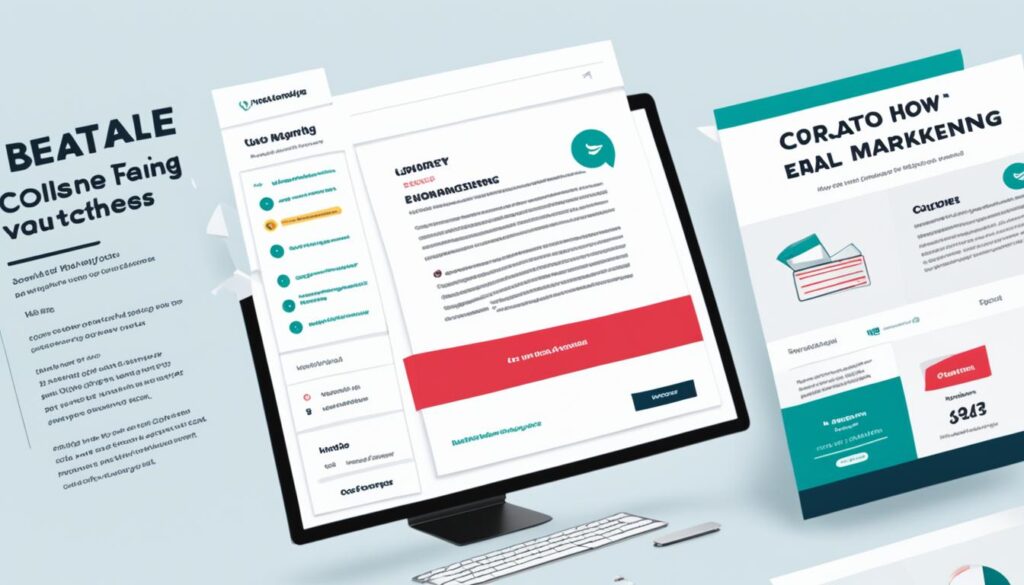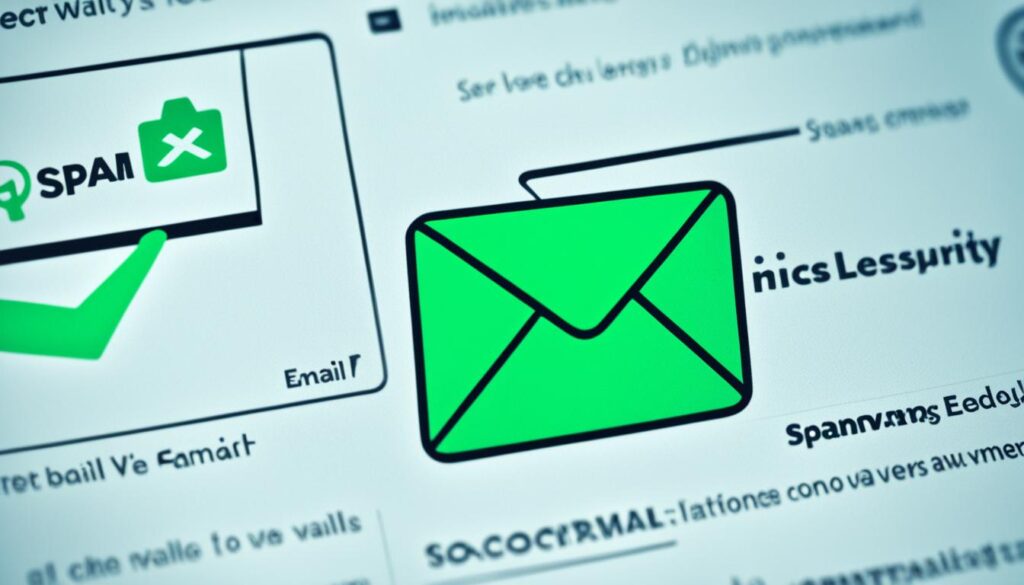Email marketing is a powerful way for online businesses to reach out and grow. It helps connect with customers and drive sales through targeted emails. This article will dive into email marketing tactics. You’ll see how they can help your online business shine in a crowded marketplace.

Key Takeaways:
- Email marketing is crucial for talking directly and effectively with your audience.
- Delivering great content and deals helps build good customer relationships.
- Segmenting your list and tailoring messages are keys to email marketing success.
- Using email automation and keeping an eye on performance metrics is vital.
- It’s a budget-friendly strategy that can really boost your online business.
What is Email Marketing?
Email marketing lets businesses directly talk with their audience through email. It’s a way to directly share important content, deals, or news. This method helps businesses reach more people and control their messages.
Through email, companies can build strong relationships with their customers. They can keep their audience engaged by sharing helpful content. This includes personalized product ideas, industry news, and special deals. Email lets businesses share this valuable info straight to their subscribers.
“Email marketing provides a direct and personal way to reach your customers, delivering valuable content, special offers, or news straight to their inboxes.”
Email marketing is unique because it allows personalized messages. Businesses can make their messages more relevant by knowing their customers’ likes and actions. This way, every email can feel specially made for each subscriber.
Moreover, email marketing lets businesses see how well their campaigns are doing. They can look at open rates and clicks to learn what works best. This helps in making future emails even better. This approach helps make every email campaign stronger over time.
In short, email marketing is a key way for businesses to talk with their audience. It allows sending direct email messages to keep the audience engaged. Whether to keep customers close or boost sales, email marketing is a personal and powerful tool.
Email Marketing in Action: A Case Study
Let’s see how email marketing worked for XYZ Company, a business selling organic skincare. They used emails to get more customer interaction and increase sales.
| Email Marketing Campaign Goals: | Results: |
|---|---|
| Increase customer engagement | Open rates increased by 20% |
| Drive website traffic | Click-through rates increased by 15% |
| Boost sales | Revenue from email campaigns increased by 25% |
By sending targeted emails, XYZ Company boosted customer involvement. Their emails had personal product suggestions and exclusive deals. This led to more opens and clicks. As a result, their email-based revenue went up significantly.
Key Takeaways
- Email marketing allows businesses to connect directly with their audience through targeted email messages.
- It provides a means of direct communication and enables businesses to deliver valuable content, special offers, or news.
- Personalization and segmentation play a crucial role in delivering relevant and engaging email content.
- Tracking and analyzing email campaign metrics helps businesses refine their strategies and optimize performance.
Understanding Your Audience for Successful Email Marketing
To succeed in email marketing, knowing your audience is key. By analyzing their demographics, interests, and needs, you can craft content that truly speaks to them. This makes your campaigns more effective.
Segmentation plays a big role in email marketing. It involves dividing your email list into smaller groups based on various factors. These could include demographics, preferences, or behaviors. You can then send messages tailored to each group. This method leads to more engagement and better results.
Why Targeted Content Matters
Personalized content grabs your audience’s attention and encourages action. If emails match their interests and needs, subscribers are more likely to interact. This boosts click-through rates and conversions, making your campaign more successful.
“Segmenting your email list allows you to send tailored messages to specific groups of subscribers, delivering more personalized and targeted content based on demographics, preferences, or behavior.”
Segmentation also brings more value to your audience. By knowing their interests, you can provide content that solves their problems or offers something special. This builds trust and loyalty, strengthening your relationship with them.
Implementing Segmentation
Starting segmentation is straightforward. First, gather data from your subscribers like age, location, or purchase history. Then, create segments that align with your business and marketing goals.
Popular segmentation categories include demographics, interests, and behavior. By using these categories, you can design campaigns that resonate with specific subscriber groups, leading to satisfaction and higher conversion rates.
Remember, effective email marketing means connecting personally with your audience. By knowing their needs and preferences, you can craft emails that engage, educate, and motivate them to take action.
| Segment | Characteristics | Example Email Content |
|---|---|---|
| New Subscribers | Recently signed up for your email list | Welcome email series, introducing your brand and offering a discount code for their first purchase |
| Loyal Customers | Regularly engage with your brand and make repeat purchases | Exclusive offers, loyalty rewards, and sneak peeks of new products or services |
| Cart Abandoners | Added items to their cart but did not complete the purchase | Reminder emails highlighting the items left in their cart and offering an incentive to complete the purchase |
| Segment based on preferences | Subscribers with specific interests or preferences | Content tailored to their interests, such as blog articles, product recommendations, or relevant industry news |

Building an Effective Email Marketing Campaign
To create a winning email marketing campaign, careful planning and execution are key. You can expand your email list and stick to permission-based marketing.
1. Utilize Pop-up Forms
Pop-up forms on your website are a great way to boost your email list. They grab the visitor’s attention and prompt them to subscribe. Providing exclusive content or discounts can motivate them to sign up.
2. Offer Gated Content
Offering gated content is another way to grow your list. By requiring an email address for access to e-books or reports, you boost your list and show your expertise.
3. Create Compelling Landing Pages
A compelling landing page can greatly increase your email list. It should have persuasive text, striking visuals, and a clear call-to-action. Keep the subscription form simple and easy to complete.
It’s important to focus on permission-based marketing to keep subscribers’ trust and engagement. Use opt-in strategies and be clear about what subscribers will receive for a good user experience.

| Benefits of Building an Effective Email Marketing Campaign | Strategies for Growing your Email Subscriber List |
|---|---|
| 1. Increased brand awareness | 1. Utilize pop-up forms |
| 2. Improved customer engagement | 2. Offer gated content |
| 3. Enhanced lead generation | 3. Create compelling landing pages |
| 4. Higher conversion rates | |
| 5. Increased customer retention |
With these strategies, your email marketing campaign will not only grow your list. It will also enhance engagement, conversions, and customer loyalty.
Types of Email Campaigns and Best Practices
Email marketing uses different campaigns for various goals. Knowing the difference between promotional, informational, and transactional emails helps make your campaigns more effective.
Promotional Emails
Promotional emails aim to boost sales with deals or product highlights. They feature eye-catching visuals and persuasive words to encourage action. For successful promotional emails:
- Personalize the content based on customer preferences and behavior.
- Segment your audience to ensure targeted messaging.
- Use engaging subject lines to capture attention.
Informational Emails
Informational emails build customer relationships by providing useful content or updates. They establish your brand as a reliable source. To craft effective informational emails:
- Deliver relevant and useful information to address customer pain points.
- Include visually appealing visuals to enhance engagement.
- Personalize the content to make it relevant to each subscriber.
Transactional Emails
Transactional emails are sent after specific customer actions like buying something. They’re a chance to engage customers and suggest additional offers. For better transactional emails:
- Ensure clear and concise information related to the customer’s actions.
- Include personalized product recommendations or relevant offers.
- Utilize branded email templates for consistent messaging.
Remember, personalization, clear calls-to-action, and branded templates are key elements for creating engaging and effective email campaigns.
Using responsive branded email templates is key for consistent branding across devices. This maintains a professional look and enhances user experience. Designing appealing templates that match your brand identity is worth the effort.
Consider how a well-designed template can make a promotional email much more effective:

| Before | After |
|---|---|
| Generic email with plain text | Branded email with visually appealing graphics and cohesive design |
| Uninspiring layout | Eye-catching design that grabs attention |
| No clear hierarchy or organization | Clear sections, easy to read and navigate |
| No branding elements | Consistent branding, building brand recognition |
A well-done branded template not only looks good but also boosts your brand’s credibility and recognition. The right design really can make a difference in your email campaigns.
The Power of Email Automation
Email automation changes the game for online businesses. It saves time and boosts campaign efficiency. Email automation allows for triggered campaigns that send targeted emails based on what customers do.
Imagine a customer adds products to their cart but doesn’t buy. Email automation lets you remind them to finish buying. This nudge can really help increase sales.
Email workflows push automation further by nurturing leads. They guide potential customers through the buying process with automated emails. These emails keep people interested and informed, helping them decide to buy.
Segmenting your email list boosts personalization. By organizing subscribers by preferences or actions, you can tailor your messages. This makes each email more relevant to its receiver, improving chances they’ll act.
The Benefits of Email Automation:
- Save time and improve efficiency
- Increase conversion rates with triggered campaigns
- Nurture leads and guide them through the sales funnel with email workflows
- Enhance personalization and targeting through email list segmentation

Email automation is a must for effective email marketing. It involves triggered campaigns, email workflows, and smart list segmentation. These elements lead to personalized emails that get results. So, harness email automation and elevate your email marketing.
Tracking and Analyzing Email Marketing Performance
To figure out if your email marketing is working, keeping an eye on email metrics is key. Things like open rates, click-through rates, and conversion rates can tell you a lot. They help understand if your email tactics are effective.
Open rates show how many people opened your email. This measures if your email grabs attention. Click-through rates look at who clicked on links, showing their interest. Conversion rates are about how many did what you wanted, like buying something or signing up.
To better understand these metrics, companies use tools for email analytics. These tools give detailed reports and knowledge. This lets you see how people are responding, spot trends, and make smart changes to your emails.
Key Email Metrics
When reviewing your campaign’s success, these email metrics are crucial:
- Email Open Rates: This shows the share of people who opened your email. It checks if your subject line works well and tracks audience interest.
- Click-through Rates (CTR): CTR looks at the share of people who clicked a link in your email. It’s about how well your email gets people to act.
- Conversion Rates: This metric follows the share who did a specific action, like buying something. It’s vital for seeing how well your email leads to results.
Email Analytics Tools
Email analytics tools help businesses track email metrics effectively. They provide deep insights into how campaigns are doing. With this info, you can see what’s working, what isn’t, and decide how to improve.
Well-known tools for email analytics include:
- Email Metrics: This tool helps track key email metrics like open and click-through rates. It gives detailed reports and visuals to understand campaign results.
- Email Analyzer: It offers deep analytics including heatmaps and A/B tests. This tool gives insights that help fine-tune emails for better outcomes.
- Email Performance Tracking: This tool lets businesses see how their emails are doing. It shows data on open rates, click-through rates, and more, helping improve strategy.
Analyzing Engagement Data
Studying data from email metrics helps businesses customize their emails to fit what their audience likes. By looking at trends and areas to get better, emails can be made more effective.
Engagement data analysis can reveal:
- How well your email’s subject lines and content catch interest and lead to opens.
- Which calls-to-action and links work best in your emails.
- How to segment and personalize emails based on what your audience prefers.
- The role of design and layout in getting clicks and actions.

Overcoming Email Deliverability Challenges
Email marketing faces a big problem: email deliverability. It’s not just about making great email campaigns. You have to make sure they get to your audience’s inboxes. To beat this, follow these practices:
- Use a reputable email service provider: Working with a good email service can help a lot. They have connections with ISPs and help your emails get seen as real and safe.
- Authenticate your emails: Using SPF, DKIM, and DMARC helps prove you’re a real sender. This makes ISPs trust your emails more, keeping them out of spam.
- Avoid trigger words: Some words, like “free,” “discount,” or “urgent,” can make your emails hit spam filters. Use these words carefully.
- Optimize email design: How your email looks is key. Make sure they work on phones, are easy to read, and balance text and pictures. Don’t overload them with too much HTML or big files.
- Keep the email list clean: Regularly check your email list and remove bad addresses. This keeps your sender reputation solid and makes sure you’re reaching people who want your emails.
- Build engagement and segment your list: Keeping your audience interested and tailoring your emails to their likes helps a lot. Targeted emails to specific groups mean better open and interaction rates.
Use these practices to get better at sending emails. Doing so will boost the success of your email marketing.

Increased Brand Awareness and Customer Engagement through Email Marketing
Email marketing boosts online businesses by raising brand awareness and engaging customers. By talking regularly with their audience, companies keep their brand fresh in customers’ minds. They also share important updates.
Communicating often helps brands become industry leaders and gain customer trust. Companies can show their knowledge, share insights, and offer special deals through emails. This creates excitement and anticipation among the audience.
“Email marketing allows brands to stay connected with their audience, fostering meaningful relationships and driving customer loyalty. By consistently delivering valuable content, businesses can position themselves as trusted advisors in their industry.”
Email marketing opens the door for conversations with customers unlike other channels. It offers a direct way to talk, strengthening bonds. This also lets businesses learn from customer feedback.
Businesses can personalize their emails based on what customers like and do. They can send messages to specific groups, making the content more relevant and engaging for each subscriber.
For better engagement, it’s essential to create great email content. This could be informative articles, tips, personalized suggestions, or unique discounts. High-quality content helps build a community around the brand.
Case Study: How XYZ Company Increased Brand Awareness through Email Marketing
| Brand Awareness Metrics | Before Email Marketing | After Email Marketing |
|---|---|---|
| Website Traffic | 1,000 monthly visitors | 10,000 monthly visitors |
| Social Media Followers | 500 followers | 5,000 followers |
| Online Mentions | 10 monthly mentions | 100 monthly mentions |

After starting email marketing, XYZ Company saw a big rise in brand visibility. Their website visitors jumped from 1,000 to 10,000 a month. Their social media following also grew from 500 to 5,000, showing email’s impact on community growth. Plus, the company’s online mentions increased tenfold, marking a stronger brand presence online.
In conclusion, email marketing is a strong way for businesses to grow brand awareness and connect with customers. By communicating regularly and sharing useful content, businesses can become industry leaders. They build trust and form meaningful connections that lead to lasting success.
Personalize Communication and Targeted Messaging in Email Marketing
Email marketing lets companies talk to their subscribers in a personal way. They use subscriber info to make the customer’s experience better and boost sales chances.
Segmentation splits the email list into groups like age, interests, or what they bought before. This means companies can send stuff that fits each group’s likes, from product tips to special deals.
**Personalization tools** help make emails feel made just for the reader. They let companies put things like the person’s name or what they bought before right into the email. This makes the emails feel special and builds trust.
When emails feel personal and the messages hit the right spot, people pay more attention. This makes them feel important and not just part of a big crowd.
Personal and targeted emails have big perks:
- Increased engagement: If emails match what people like, they’re more likely to read and respond.
- Improved conversions: Personal tips and deals can make people want to buy more.
- Enhanced brand loyalty: When companies understand their customers, trust grows. This means people keep coming back.
“Personalized communication is not just about addressing subscribers by their names. It’s about understanding their preferences, needs, and behaviors to deliver targeted messages that resonate with them.”
Using personalization tools and segmentation boosts email marketing. Tailoring messages to each subscriber can make your strategy more affecting and successful.

| BENEFITS OF PERSONALIZED COMMUNICATION | TARGETED MESSAGING | SEGMENTATION | PERSONALIZATION TOOLS |
|---|---|---|---|
| Increased engagement | Delivering relevant content | Divide email list based on criteria | Dynamically insert subscriber data |
| Improved conversions | Personalized product recommendations | Send targeted messages | Customize emails with subscriber information |
| Enhanced brand loyalty | Exclusive promotions | Create deeper connections | Build stronger relationships |
Improved Customer Loyalty and Retention through Email Marketing
Email marketing is very effective for boosting customer loyalty and retention. By keeping in touch with subscribers and giving them special content, businesses can make their customers feel valued and loyal.
Targeted messaging is a great way to improve customer loyalty. By dividing your email list and customizing your messages for different groups, you can share personalized content that matches their interests. This way, customers feel a closer bond with your brand, which boosts their loyalty and engagement.
Sending follow-up emails is key to keeping customers. Reaching out after they make a purchase or interact with you helps reinforce their good feelings. These emails remind them why they chose your brand, which keeps them loyal and happy.
“Email marketing allows businesses to create a personal and direct line of communication with their customers. Through timely and tailored messages, businesses can nurture customer relationships and foster long-term loyalty.” – Jane Johnson, Email Marketing Expert
Offering exclusive content to email subscribers also helps with loyalty. This can be special deals, early looks, or unique content not available to the public. By giving these exclusives, you show subscribers they’re important, which makes them stick with your brand.
Customer Retention Strategies
Using customer retention strategies with your email campaigns can boost loyalty even more. Some smart strategies include:
- Implementing a loyalty program that rewards customers for their continued support.
- Offering personalized product recommendations based on customers’ past purchases or preferences.
- Sending targeted surveys to gather feedback and gain insights into customers’ needs and preferences.
- Providing exceptional customer service to ensure positive experiences and resolve any issues promptly.
By mixing these retention strategies with your email campaigns, you create a strong plan. This plan helps increase customer loyalty and reduce turnovers.

In conclusion, email marketing is an excellent way to enhance customer loyalty and retention. With targeted messages, follow-up emails, and exclusive content, businesses can build lasting relationships with their customers. By also using customer retention techniques, businesses can ensure long-term loyalty. This leads to ongoing growth and success.
Cost-effective Email Marketing with High ROI
Email marketing is great for businesses wanting to get the most from their marketing. It needs little money to start but promises big returns. This makes it perfect for all kinds of companies.
It works well because you can target certain groups of people. By dividing your email list and sending personal messages, you hit the right audience at the best time. This makes people more likely to react, helping you get the most from every email.
Another plus is being able to see how well your campaigns do. With good tools, you’ll understand what your audience likes and does. This info lets you make your emails even better, ensuring high returns.
Email marketing also costs less than other ways of reaching out. No need for pricey print stuff or mailing costs. And, with email tools and services, handling your campaigns is easy without a big team. This makes email marketing very budget-friendly.